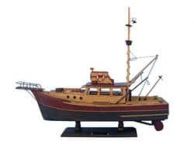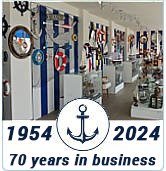|
|
| (9 Items) Sort: | Items: 1 to 9 |
Fishing Boat Models
Hardworking, hearty, and durable vessels, Fishing Boats have trawled the seas for centuries providing landlubbers with fine catches against great odds. Enjoy the charm of the Lobster Mobster, the pride of the Andrea Gail, or the delightful Orca from the movie Jaws. With museum quality ship replicas, Handcrafted Model Ships is proud to offer you these amazing Fishing Boat models.
Handcrafted Model Ships is pleased to offer a wide array of fishing boat models, spanning a designs and types from small cutters and traditional artisan craft to modern fishing boats designed specifically for gathering fish, crab, lobsters or shrimp. Our collection also includes several famous and beloved fishing boats drawn from both the fiction of movies and television as well as real-life, actively-working ships known for their enduring hard work.
For thousands of years fishermen and the boats they sail have played a vital role in not only human food-gathering and local economies, but indeed influenced advances in maritime technology and economic development on a global scale. With ever-increasing knowledge of the health benefits of a seafood-rich diet and understanding of the ecological importance of the world’s oceans, fishermen and their boats remain important harvesters and custodians of the sea.
Some 4 million commercial fishing boats, plus uncounted millions more sport and recreational craft, currently operate upon the world’s seas and oceans. Of these, it is estimated that only 1.3 million (or 1/3rd) are modern, decked craft that include enclosed areas as well as storage and processing holds for their catch. Of the remainder, 2/3rds (or nearly half of all fishing boats) are estimated to be traditional sailboats or rowboats used by artisan fishers who engage in subsistence or small-scale commercial fishing in island and coastal areas, as well as upon lakes and rivers.
Depictions in artwork from ancient Egypt through the middle ages reveal that boats used for fishing were generally adapted from other types of crafts. It was only in the late medieval period that boats were designed and built specifically to optimize their ability to function as dedicated fishing craft. This evolution continued into the Age of Sail, as commercial fishing evolved into a major industry of several northern European countries. Fleets made up of hundreds of fishing craft could set sail for weeks, months or (in the case of some whalers) even years at sea, preserving their catch in salt and barreling it for storage until it could be transferred to shore.
Throughout the Age of Sail, the design of fishing boats varied as greatly by nation, region or even the individual shipyard as it did according to the intended catch or the function of the vessel. It was not until the 1950s when modern, mechanized commercial fishing boats became increasingly constructed of steel or fiberglass that their design became more standardized.
Several different techniques and methods of fishing exist, depending upon the location, active fisheries and type of catch a boat is pursuing. Actual “fish” are commonly caught by trawlers, which drag large next beside or behind themselves as they cruise through the water. Another type of net is the “seiner” or purse seine net, which is used to encircle an entire school of fish before being drawn closed and hauled aboard. Some larger species are still fished baited hooks on long-lines hung from poles or booms along the sides or stern of the vessel as it cruises slowly through the sea.
Shrimp boats, or “shrimpers”, use similar methods to regular fishing boats, relying primarily on trawling or purse seine nets. Baiting and trapping are less common techniques for shrimping, but the primary method of catching both crab and lobster. Large cages known as “crab pots” are baited and lowered to the sea floor, their location marked with buoys. After laying all of its pots, a crab boat circles back and begins recovering them after a period of several hours. Dozens or perhaps even hundreds of crab may be caught in a single pot. Lobster traps are generally smaller than crab pots and include an “escape hatch” through which juvenile or undersized lobster may exit the trap, but otherwise function in essentially the same way.
Although lobster may be harvested by diving, including the use of scuba equipment, a single artisan lobsterman in a small boat is able to set, harvest and then reset as many as 100 traps in a single day, yielding a catch of 100 -1,000 lobster. By comparison, a large commercial crab boat may carry as many as 250 pots which can each contain over 100 crab. Tens of thousands of live crab may be stored within the ship’s internal tanks over the course of a days-long expedition until the ship is able to return to port and off-load them.
The largest and most advanced fishing ships today are known as “factory ships”. Rather than returning their catch to a processing facility on shore, these massive boats are actually able to process the fish into slabs, fillets or other finished and packaged frozen product within hours of being caught. Some factory ships operate independently, while others serve as the mother ship for a fleet of smaller vessels, processing at-sea near the fisheries the boats are actively working.
Yet, despite these advances in large-scale commercial fishing intended to feed massive populations in developed countries, the Food and Agriculture Organization of the United Nations (FAO) estimates that nearly half of all fishing remains the business of traditional fisherman in modest, open sailboats and rowboats, focused on sustenance and small-scale commercial fishing in the ways their ancestors have for uncounted generations.
 Handcrafted
Handcrafted Handcrafted
Handcrafted Handcrafted
Handcrafted Handcrafted
Handcrafted Handcrafted
Handcrafted Handcrafted Model Ships
Handcrafted Model Ships





















